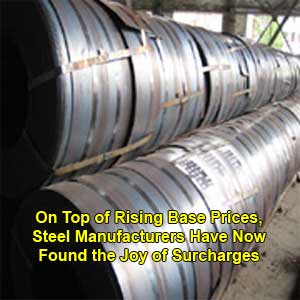 For many manufacturers, however, such substitution is not an option. Even for those for which it is, there will generally be considerable time required to engineer, qualify and implement alternative materials. For many manufacturers, however, such substitution is not an option. Even for those for which it is, there will generally be considerable time required to engineer, qualify and implement alternative materials.
Automakers are subject to both constraints – a requirement to use steel for many parts, and a long time required for switching even where they can. With their backs up against the financial wall, some are starting to push back.
The Wall Street Journal reported this week that “Some auto makers are threatening to fight the additional charges in court, saying that financial terms of a contract can't be altered.”
There are some customers who have accepted the surcharges and some who have not," says Aditya Mittal, chief financial officer at ArcelorMittal. "For those who have not, we are still in negotiations."
Steel producers dispute the contentions of some auto OEMs and other manufacturers that they do not have the right to add the surcharges under the terms agreed upon within the existing contracts.
As always, supply and demand is a key underlying force. Overall global demand for steel has kept capacity tight, giving steel makers more confidence in making price increases stick. The increasing consolidation in the industry also means fewer companies have control of the supply side of the steel equation.
What to Do in New Contracts?
Many manufacturers are entering the usual contract negotiating period for steel.
One response to the current situation might be to insist on locking in a final price in new contracts, rather than a base price, as is found in most contracts today.
But while that strategy may seem appealing in today’s environment, it could also backfire. If energy prices pull back, as many expect, or the iron ore bubble pops, buyers might wish they were back to a base price model, as surcharges would drop dramatically, offering a total price that might be well below contracted final prices.
One thing for sure is to keep very informed about true cost drivers for steel producers, such as iron ore prices and energy costs. While there is no question that these input prices have risen dramatically, it is equally certain that many steel producers will use the current turmoil to try to extract extra price increases above input cost inflation.
But most experts for now expect the price of steel to continue to head north. Steel industry consultant Michael Locker, for example, says he believes prices for hot-rolled coil will go to about $1,500 per ton from the current level of between $1,100 to $1,200.
What’s your opinion on the phenomena of steel price surcharges? Would you recommend negotiating fixed final prices or not? Let us know your thoughts at the Feedback button below. |